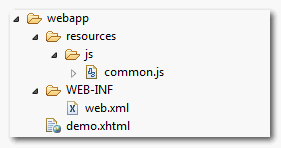In JSF 2.0, you can use <h:outputScript /> tag to render a HTML “script” element, and link it to a js file.
For example,
<h:outputScript library="js" name="common.js" />
It will generate following HTML output…
<script type="text/javascript"
src="/JavaServerFaces/faces/javax.faces.resource/common.js?ln=js">
</script>
JSF outputScript example
An example to show you how to use <h:outputScript /> to render a “common.js“, see figure below :

JSF file
``
<h1>JSF 2 outputScript example</h1>
<h:outputScript library="js" name="common.js" />
</h:body>
<h1>JSF 2 outputScript example</h1>
<script type="text/javascript"
src="/JavaServerFaces/faces/javax.faces.resource/common.js?ln=js">
</script>
In addition, you can use “target” attribute to control where to output the js file.
- target=”head” – Display within the top of HTML head tag.
- target=”body” – Display at the end of the body tag.
- no target – Display at where the tag is placed.
For example
<h:outputScript library="js" name="common.js" target="body" />
It will generate following HTML output
<?xml version="1.0" encoding="UTF-8"?>
<!DOCTYPE html PUBLIC "-//W3C//DTD XHTML 1.0 Transitional//EN"
"http://www.w3.org/TR/xhtml1/DTD/xhtml1-transitional.dtd">
<html xmlns="http://www.w3.org/1999/xhtml">
<head>
</head>
<body>
<h1>JSF 2 outputScript example</h1>
<script type="text/javascript"
src="/JavaServerFaces/faces/javax.faces.resource/common.js?ln=js">
</script>
</body>
</html>